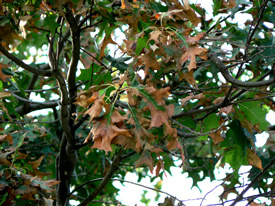

Bacterial scorch symptoms on oak leaves.
|
|
| Severity: | 4 out of 5 |
| Frequency: | 2 out of 5 |
| Symptoms: | Browning of leaf margins (leaf scorch) occurs in mid- to late summer. In elm, some oaks, and mulberry, a yellow margin sometimes develops between scorched leaf margins and healthy green inner leaf tissue. In sycamore and oak, the interior edge of symptomatic leaf tissue often is red-brown. Severely scorched oak and mulberry leaves drop earlier than healthy leaves. In sycamore, symptomatic leaves curl upward but remain attached. Initially a single branch develops leaf scorch symptoms. Symptoms recur each year, with an increase in the number of branches affected. Growth reduction and dieback of affected branches occurs in severely affected trees. No discoloration is visible in the wood of symptomatic branches, in contrast to fungal vascular wilt diseases such as oak wilt or Dutch elm disease. Symptoms of bacterial leaf scorch may resemble those caused by noninfectious disorders such as drought stress or wind desiccation. Confirmation of bacterial leaf scorch involves a serological test performed on petioles of scorched leaves. |
| Cycle: | The bacterium has been found in a large number of herbaceous and woody plant hosts, but many infected plants show few, if any, symptoms. Xylem-feeding sharpshooter leafhoppers and spittlebugs are known to spread the bacterium in grape and peach and are believed to be the vectors in landscape trees as well. In some hosts, the pathogen can spread through root grafts, however, this method of trasmission and its importance has yet to be verified in ornamental shade trees. |
| Management: | Currently, cultural practices to alleviate root stress in infected trees are the only means of extending the life of an infected tree. Control of insect vectors is not practical, and there are no chemical treatments to prevent infection or to use as therapy on infected trees. If an infected tree shows extensive dieback and leaf scorch, it should be removed. |
| Associated trees: | |